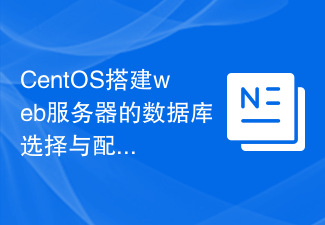
In-depth understanding of Java Servlet development experience and suggestions
1. Introduction
Java Servlet is one of the Web development technologies based on the Java language. It provides a web programming approach based on the request and response model, aiming to simplify and optimize the development of web applications. This article will share some experiences and suggestions for in-depth understanding of Java Servlet development, hoping to be helpful to Java developers.
2. Understand the basic concepts of Servlet
Before we start to learn and understand Java Servlet in depth, we need to understand the basic concept of Servlet. Servlet is a Java class that plays the role of a controller for a Web application, processing client requests and generating responses. Learn the core concepts of Servlet including Servlet life cycle, Servlet API, Servlet container, etc. A deep understanding of these concepts is the basis for mastering Servlet development.
3. Pay attention to the life cycle of Servlet
The life cycle of Servlet includes three stages: initialization, service and destruction. In the initialization phase, we can do some initialization operations, such as establishing a database connection, loading configuration, etc. In the service phase, the Servlet will receive the client's request and process it accordingly. During the destruction phase, we should release resources and do some cleanup. A deep understanding of the Servlet life cycle will help us better control the behavior of the application.
4. Flexible use of Servlet API
Servlet API is an important part of Servlet development. It provides a rich set of interfaces and classes for processing HTTP requests, accessing request parameters, setting response headers, generating responses, etc. During the development process, we should be proficient in the use of Servlet API in order to efficiently handle client requests. For example, we can use the HttpServletRequest interface to obtain the information requested by the client, and use the HttpServletResponse class to generate a response and send it to the client. Flexible use of Servlet API will significantly enhance our ability to develop Web applications.
5. Make full use of the functions of the Servlet container
The Servlet container is an environment used to run and manage Servlets. It is responsible for managing the life cycle of Servlet, scheduling requests and responses, etc. Different Servlet containers provide different functions and features, and we should make full use of them to simplify and speed up development. For example, Tomcat is a commonly used Servlet container. It provides a hot deployment function, which can take effect directly without restarting the container after modifying the code. Understanding and making full use of the functions of the Servlet container will improve our development efficiency.
6. Optimize the performance of Servlet
In order to improve the performance of Web applications, we need to optimize the performance of Servlet. On the one hand, we can reduce resource consumption by reducing unnecessary object creation and method calls. On the other hand, we can use caching technology to improve the speed of request response. For example, we can cache some static resources into the client's browser to reduce the load on the server. By optimizing the performance of Servlets, we can provide a better user experience.
7. Handling exceptions and security issues
In actual development, we often encounter exceptions and security issues. In order to ensure the reliability and security of the application, we need to handle these issues appropriately. For example, when encountering an exception, we can capture it and handle it appropriately, giving the user a good prompt message. When dealing with security issues, we should use appropriate authorization and authentication methods to ensure that only legitimate users can access sensitive resources. A deep understanding of how exceptions and security issues are handled will improve the stability and security of our applications.
8. Continuous learning and exploration
As a commonly used Web development technology, Java Servlet requires us to continue learning and exploring. With the development of the Java ecosystem and the emergence of new technologies, we should keep abreast of and master the latest development methods and tools. Through continuous learning and exploration, we can continuously improve our development level to adapt to the rapidly changing technical environment.
9. Summary
This article shares the experience and suggestions for in-depth understanding of Java Servlet development. Through in-depth understanding of the basic concepts of Servlet, attention to the life cycle of Servlet, flexible use of Servlet API, full use of Servlet container functions, optimization of Servlet performance, handling of exceptions and security issues, continuous learning and exploration, etc., we can gain more experience and suggestions. Develop and manage web applications well. I hope this article can provide some guidance for Java developers in Servlet development.
The above is the detailed content of In-depth understanding of Java Servlet development experience and suggestions. For more information, please follow other related articles on the PHP Chinese website!
 PHP开发心得分享:掌握各种功能实现的经验与建议Nov 22, 2023 pm 12:02 PM
PHP开发心得分享:掌握各种功能实现的经验与建议Nov 22, 2023 pm 12:02 PM在当前互联网高速发展的时代,PHP作为一种服务器端脚本语言,被越来越多的开发者所采用。PHP具有简单易学、灵活、开源免费等优势,可以快速开发各种网站和Web应用。然而,作为一名PHP开发者,要想在激烈的竞争中脱颖而出并写出高效稳定的代码,还需要掌握各种功能的实现技巧和经验。首先,合理规划项目架构是开发PHP应用的关键。一个良好的项目架构可以提供更好的代码可维
 PHP 错误处理:最佳实践和建议Aug 07, 2023 pm 12:25 PM
PHP 错误处理:最佳实践和建议Aug 07, 2023 pm 12:25 PMPHP错误处理:最佳实践和建议在编写PHP代码时,错误处理是一项非常重要的任务。如果不正确地处理错误,就会导致应用程序中的漏洞和安全问题。同时,良好的错误处理还有助于提高代码的可维护性和可扩展性。本文将介绍一些PHP错误处理的最佳实践和建议,并提供一些代码示例。使用异常处理在PHP中,异常是一种用于处理运行时错误的机制。通过使用异常,可以将错误
 踩过的坑:Go语言项目开发经验与教训Nov 03, 2023 am 08:14 AM
踩过的坑:Go语言项目开发经验与教训Nov 03, 2023 am 08:14 AM踩过的坑:Go语言项目开发经验与教训在软件开发的道路上,每个开发者都会不可避免地踩过一些坑。当然,对于Go语言的开发者来说也不例外。本文将分享我在使用Go语言进行项目开发过程中所踩过的坑,希望能给其他开发者带来一些经验和教训。不同版本的Go语言在使用Go语言进行项目开发时,我们必须关注Go语言的版本。不同版本之间可能存在一些语言上的差异或者API的变动,这些
 C++开发建议:如何进行模块化的C++开发Nov 23, 2023 am 08:56 AM
C++开发建议:如何进行模块化的C++开发Nov 23, 2023 am 08:56 AMC++语言作为一种通用的高级编程语言,被广泛用于开发各种应用程序和系统。然而,C++的复杂性和灵活性也使得开发人员面临着一些挑战,特别是在大型项目中。在处理大型项目时,模块化的开发方法是至关重要的。本文将介绍如何进行模块化的C++开发,并提供一些建议和最佳实践。模块化开发是指将一个大型项目划分为多个小模块,每个模块有自己的功能和职责,通过模块间的接口进行通信
 升级到Win11 - 2022年是否明智?Jan 04, 2024 pm 10:58 PM
升级到Win11 - 2022年是否明智?Jan 04, 2024 pm 10:58 PM距离Win11系统发布已经过去了一年的时间,许多人一直想知道2022年是否建议升级至Win11。实际上,如果我们目前使用的系统感觉良好并且没有遇到任何问题,那么升级并不是必须的。答:2022年不建议升级win11,因为现在win11相比win11并没有多少提升。如果我们喜欢Win11的全新界面和设置,不妨下载来试试看看。1、现在win11和win10的软件兼容性没啥区别,能在win11用的win10也能用。2、如果我们习惯了win10操作的话,win11可能还用着不习惯,很多功能找不到。3、例如
 深入理解Java GUI开发的经验与建议Nov 22, 2023 am 10:10 AM
深入理解Java GUI开发的经验与建议Nov 22, 2023 am 10:10 AM深入理解JavaGUI开发的经验与建议作为一种常用的面向对象编程语言,Java在软件开发中扮演着举足轻重的角色。而在Java开发中,GUI(GraphicalUserInterface)即图形用户界面的开发更是日常工作中所需要掌握的重要技能之一。在GUI开发中,丰富的用户界面和交互性能会直接影响到软件的用户体验和用户满意度,因此,深入理解
 C++开发建议:如何进行C++测试驱动开发Nov 22, 2023 am 11:36 AM
C++开发建议:如何进行C++测试驱动开发Nov 22, 2023 am 11:36 AMC++是一种高效、可靠、可扩展性强的编程语言,适合用于开发各种类型的软件。在开发C++应用程序时,测试驱动开发(TDD)是一种可行的方法,可以确保代码的质量并提高开发效率。本文将介绍如何进行C++测试驱动开发。理解测试驱动开发测试驱动开发是一种软件开发方法,其核心理念是在实现功能之前编写测试用例。在开发的过程中,开发人员编写单元测试用例,并使用自动化测试工具
 CentOS搭建web服务器的数据库选择与配置建议Aug 05, 2023 am 09:33 AM
CentOS搭建web服务器的数据库选择与配置建议Aug 05, 2023 am 09:33 AMCentOS搭建Web服务器的数据库选择与配置建议概述:在搭建Web服务器时,数据库的选择与配置是非常重要的一环。本文将介绍在CentOS系统上搭建Web服务器时,如何选择合适的数据库,并给出相应的配置建议。同时,还会提供一些代码示例,以帮助读者更好地理解和操作。选择数据库:在选择数据库时,应根据自身需求和项目特点来决定。常见的数据库有MySQL、Postg


Hot AI Tools

Undresser.AI Undress
AI-powered app for creating realistic nude photos

AI Clothes Remover
Online AI tool for removing clothes from photos.

Undress AI Tool
Undress images for free

Clothoff.io
AI clothes remover

AI Hentai Generator
Generate AI Hentai for free.

Hot Article

Hot Tools

mPDF
mPDF is a PHP library that can generate PDF files from UTF-8 encoded HTML. The original author, Ian Back, wrote mPDF to output PDF files "on the fly" from his website and handle different languages. It is slower than original scripts like HTML2FPDF and produces larger files when using Unicode fonts, but supports CSS styles etc. and has a lot of enhancements. Supports almost all languages, including RTL (Arabic and Hebrew) and CJK (Chinese, Japanese and Korean). Supports nested block-level elements (such as P, DIV),

Notepad++7.3.1
Easy-to-use and free code editor

SAP NetWeaver Server Adapter for Eclipse
Integrate Eclipse with SAP NetWeaver application server.

VSCode Windows 64-bit Download
A free and powerful IDE editor launched by Microsoft

DVWA
Damn Vulnerable Web App (DVWA) is a PHP/MySQL web application that is very vulnerable. Its main goals are to be an aid for security professionals to test their skills and tools in a legal environment, to help web developers better understand the process of securing web applications, and to help teachers/students teach/learn in a classroom environment Web application security. The goal of DVWA is to practice some of the most common web vulnerabilities through a simple and straightforward interface, with varying degrees of difficulty. Please note that this software






